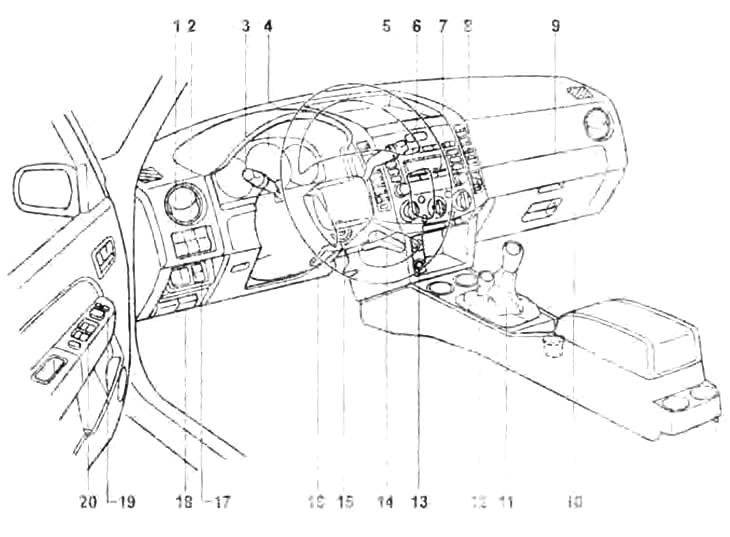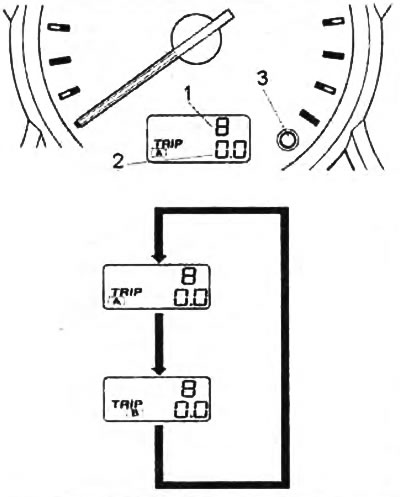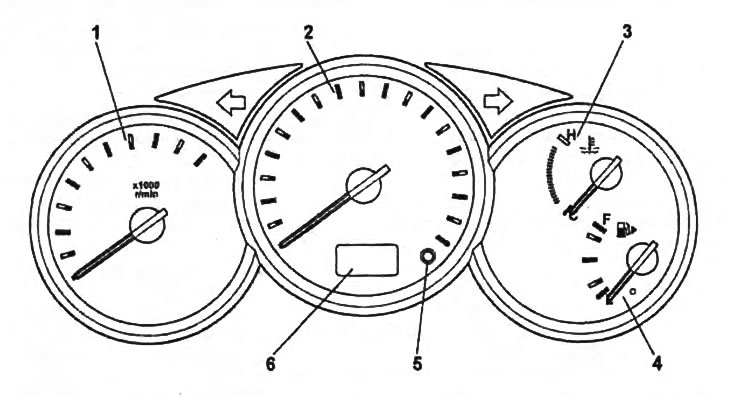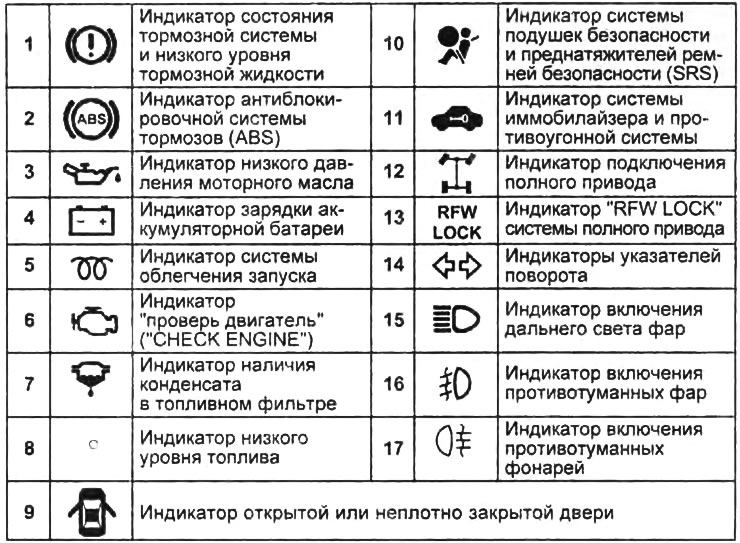
Dashboard.
1 - regulator of the headlight position correction system.
2 - brightness control of the instrument cluster backlight,
3 - switch for headlights and direction indicators,
4 - instrument cluster,
5 - wiper and washer control switch,
6 - alarm switch,
7 - audio system,
8 - control panel for air conditioning and heater,
9 - stand,
10 - glove box,
11 - manual transmission lever,
12 - transfer case control lever,
13 - connector for connecting additional devices,
14 - parking brake lever,
15 - ignition lock,
16 - steering wheel lock lever,
17 - drive button for the lock of the fuel filler hatch,
18 - hood lock drive lever,
19 - mirror position control panel,
20 - power window position control panel.
See the figure for the location of instruments and indicators "instrument cluster".
Tachometer
The tachometer shows the number of revolutions of the crankshaft of the engine per minute (rpm).
Attention: while driving, follow the readings of the tachometer. Its arrow, showing the speed of the engine shaft, should not enter the red zone (engine speed zone).
Odometer and odometer

1 - odometer,
2 - odometers,
3 - button for switching/resetting odometer readings to zero.

Instrument combination.
1 - tachometer,
2 - speedometer,
3 - coolant temperature gauge,
4 - indicator of the amount of fuel,
5 - odometer and odometer display,
6 - button for switching/resetting odometer readings to zero.
Odometer (1) shows the total mileage of the vehicle.
Odometers (2) show the distance traveled since the counter was last reset to zero.
Button (3) is designed to switch modes and to reset the mileage counters to zero. Pressing the button briefly switches between display modes" trip counter "A" -> odometer "IN". In each mode, the corresponding indicator lights up. "TRIP A", "TRIP B". Resetting the trip counter is carried out by pressing the button for a longer time (3).
Fuel gauge
Attention: do not drive with too low fuel level in the tank. Running out of fuel can lead to failure of the catalytic converter.
The pointer shows the level of fuel in the fuel tank (F - full tank. E - empty tank) when the ignition key is in this position "ON". If the pointer arrow is near the mark "E", it is recommended to refuel as soon as possible. When the fuel level in the tank is low, the indicator on the instrument panel flashes (see table "Instrument cluster indicators").
note: arrow (if there) next to the gas station icon indicates which side of the vehicle the gas cap is located.
- Fuel tank capacity - 70 l
Coolant temperature gauge
The gauge indicates the temperature of the coolant in the engine when the ignition key is in the "ON".
If the pointer arrow enters the red zone of the scale while the engine is running "H", this indicates that the engine is overheating. In this case, immediately stop the vehicle in a safe place and follow the procedures described in. subsection "Engine overheating" of this chapter. Eliminate the cause of overheating.
Instrument cluster indicators
Note: indicator number in the table "Instrument cluster indicators" corresponds to the item number.
1. Indicator of the state of the brake system and low level of brake fluid.
The indicator lights up when the ignition key is turned to the "ON" and should go out after a few seconds.
A) The indicator lights up if:
- the parking brake is on;
- low level of brake fluid or the tightness of the vacuum brake booster is broken;
- the indicator circuit is faulty.
Note: When the pressure in the brake booster system decreases, the indicator lights up.
Table. Instrument cluster indicators.

b) If the indicator lights up while driving, slow down, pull off the road and carefully stop the car. You can slow down by applying engine braking and applying the parking brake, but be sure to depress the brake pedal to turn on the brake lights to alert drivers behind you to slow down.
Check the parking brake, it may be on. If the parking brake is released and the indicator is on, or if the indicator remains on after the brake is released, there is a problem with the brake system.
Check the brake fluid level in the reservoir.
If the brake fluid level is low, add fluid and test the vehicle's braking performance in a safe place. If you think the brakes are still working well enough, carefully drive the vehicle to the nearest repair shop. If the brakes do not work, the vehicle must be towed or towed for repair.
Attention: driving a car with a low level of brake fluid is dangerous.
If the brake fluid level is normal, one of the brake circuits may be faulty.
2. Anti-lock brake indicator (ABS).
The indicator lights up when the ignition key is turned to the "ON" and should go out after a few seconds. If the indicator does not go out or lights up while driving, this is. indicates a malfunction of the anti-lock braking system (see section "Anti-lock braking system (ABS) ").
At the same time, only the brake system works on the car and the anti-lock braking system does not work. Move to the place of repair.
Caution: Pressing the brake pedal repeatedly may turn on the indicator for a few seconds.
3. Low engine oil pressure indicator
A) The indicator lights up when the ignition key is turned to the "ON" and should go out after the engine is started.
b) The indicator lights up if the engine oil pressure is too low.
V) If the indicator flashes or lights up while driving, pull over to the side of the road and turn off the ignition.
- The indicator may flash after hard braking or when the engine is idling. There is no malfunction if the indicator goes out with a slight increase in engine speed.
- The indicator may come on when the engine oil level is too low. But this indicator is not designed to inform you about a low oil level, so periodically check the level with a dipstick.
4. Battery charging indicator.
A) The indicator lights up when the ignition key is turned to the "ON" and should go out after the engine is started.
b) If the indicator lights up while driving, the charging system is faulty or the (broken off) generator drive belt. However, the engine will continue to run until the battery is completely discharged.
Turn off optional equipment (air conditioning, radio, etc.) and move to the place of repair.
5. Starting aid indicator.
The indicator informs the driver about the beginning of the start-up assistance system (turning on the glow plugs).
The system starts working after the ignition is switched on. It is recommended to start the engine only after the indicator goes out.
If the indicator lights up while driving or flashes, this indicates a malfunction in the engine start assist system.
6. Indicator "check the engine" ("CHECK ENGINE").
The indicator lights up when the ignition key is turned to the "ON" for a few seconds and then goes out, informing the driver that the engine management system is being checked.
If the indicator stays on or lights up while driving, this indicates a malfunction in the electronic engine control system and the emission control system. In this case, it is necessary to move to the place of repair and diagnose the engine control system.
7. Indicator of the presence of condensate in the fuel filter.
If the light comes on while the engine is running, it indicates that condensation has accumulated in the fuel filter or water separator.
If this occurs, remove condensation from the fuel filter or water separator (see subsection "Removal of air and condensate from the fuel system" chapters "Maintenance and general inspection and adjustment procedures").
8. Low fuel indicator. The indicator lights up when the fuel level in the tank is low. On slopes or when cornering, the indicator may come on due to fluctuations in the fuel in the tank.
9. Indicator of an open or loosely closed door.
The indicator stays on until all doors are completely closed.
10. Airbag and pretensioner indicator (SRS).
The indicator lights up when the ignition key is turned to the "ON". After a few seconds, the indicator will turn off. If the indicator does not light up or is on (flashing) while driving, there is a malfunction in the SRS system components. Contact the service center for diagnostics and repair of passive safety system components.
11. Indicator of the immobilizer and anti-theft system.
Chips can be embedded in the heads of the main and additional keys, which act as an immobilizer. This function serves to block the engine (car theft prevention). The head of the key contains a transmitter that sends a signal to the receiver. If the signal does not correspond to the registered one, then the engine start is blocked.
The indicator starts flashing at intervals of 2 when the key is turned in the ignition lock from position "ON" into position "ACC" and informs about the activation of the anti-theft system. The indicator stops flashing when the ignition key is turned to the "ON", lights up for 3 seconds and then, if the signal matches the one registered, goes out. In this case, the engine start is enabled. If the indicator flashes, this indicates a malfunction in the immobilizer system. Contact the service center for diagnostics and repair.
12. All-wheel drive connection indicator.
Lights up when all-wheel drive is turned on. See the section for more details "Transmission features of 4WD models".
13. Indicator "RFW LOCK" all-wheel drive systems.
Lights up when the four-wheel drive is turned on and goes out when the front axle is turned off using the switch. See the section for more details "Transmission features of 4WD models".
14. Turn signal indicators. The indicators flash when the direction indicators are turned on. Excessive flashing of the indicator lamps indicates a poor connection in the turn signal circuit or a failure of the turn signal lamp.
15. High beam indicator.
Illuminates when the high beam headlights are on.
16. The indicator of inclusion of antifog headlights.
Illuminates when the fog lights are on.
17. Fog lights on indicator.
Illuminates when the fog lights are on.
